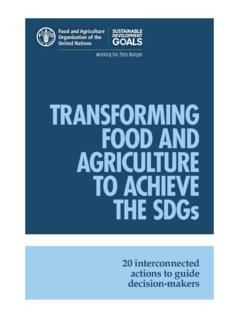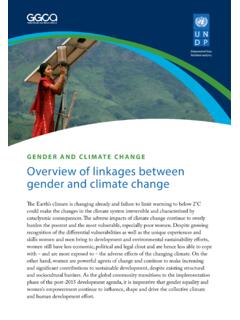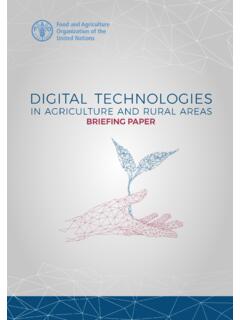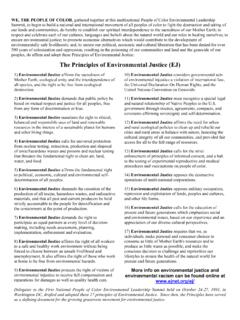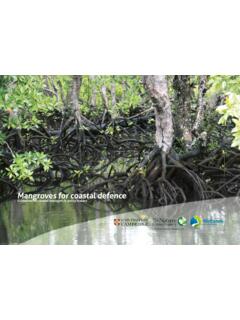Transcription of Challenges and opportunities to improve the livelihoods of ...
1 2015 Challenges and opportunities to improve the livelihoods of smallholder farmers in the Pacific Island Countries This brief contains: Production and marketing Challenges of smallholders farmers Available opportunities for the improvement of smallholders farmers production and access to markets Recommendations to mitigate smallholder farmers production and marketing Challenges BRIEF 1 This brief has been developed by Shukrullah Sherzad (Agribusiness -Junior Professional Officer, FAO-SAP), with contribution from Tim Martyn (Policy Officer, FAO-SAP) Agriculture in the Pacific Island Countries (PICs)
2 Is largely dependent on smallholder family farms. Smallholder family farmers often have access to less than two hectares (ha) of land and depend on labour supplied by household members, and few other inputs. Smallholder production strategies typically utilize a mixture of root crop, vegetable, fruit and livestock varieties for own consumption, sale and gifts, supplemented by income from cash crops such as copra, cocoa, coffee and vanilla. PIC smallholders are also extremely vulnerable to natural disasters, and price and weather variability.
3 The Challenges of poor economic geography (including small market size and large distances between internal and export markets), costly marketing infrastructure, and lack of domestic value-adding opportunities have reduced the competiveness of PIC smallholders in domestic and niche export markets. These smallholders also face strong competitive pressures due to their lack of access to improved inputs such as planting material and labour-saving machinery, and poor access to credit.
4 This has decreased their capacity to consistently meet the supply, quality and food safety standards required by modern retail outlets. In addition, consumers diets patterns have changed toward less expensive imported and convenience food products. Constraints to market integration: Smallholders face some constraints in seeking to take advantage of both domestic and export market opportunities1: (a) Constraints that inhibit production and consistency of supply: Small farmers are often unable to produce sufficient quantities to fully meet market demand, leading to lost income and to a loss of competitiveness.
5 As mentioned before production problems include: lack of suitable inputs resources, urban drift of labor from agriculture sector, low foreign investment in production and less competition with imported cheaper convenience products. Inconsistency in supply has shifted supermarkets and resorts demand toward imported products. (b) Constraints that increase market costs: Poor economic geography (remote location from markets, small land and population mass, large internal distance between islands) 4, inadequate supporting policies, weak institutional support, unreliable infrastructures and services: raises processing and marketing costs, leads to deterioration in the quality of goods and provide market opportunities for imported products in the domestic markets.
6 (c) Constraints that reduce market access: Meeting international sanitary and phytosanitary (SPS) legislation and private quality certification standards which are required by modern retailing system, can be a major challenge for smallholders7. Smallholders (those who have capacity to export) must be able to export 1 FAO Agri-food system brief: Overcoming constraints to agricultural exports 4 Challenges and constraints 2 products that meet the minimum standards required by importing countries/enterprises and should be price competitive in niche export markets.
7 Without the assistance of private-public sector and donor agencies, it is somehow difficult for stallholders to access niche export markets. (d) Constraints that break market relationship and linkages: Though both sides have an interest in doing business together, smallholders and large companies in many cases find it difficult to enter in a productive business relationship. Often, the two sides lack the mutual trust and access to one another required for successful cooperation. Structural Challenges including a lack of information, a lack of skills and knowledge, insecurity, resource scarcities, and gaps in infrastructure stand in the way.
8 Trust and access are basic requirements for success in any business relationship2. Limited access to capital and input resources: Lack of access to credit has reduced the competiveness of smallholders relative to imported products in domestic markets, and in export markets4. Although there are some development/commercial banks and micro-finance schemes providing loans to smallholders, their limited knowledge of the sector, remoteness from rural areas, high collateral requirements and resulting high interest rates given their risk perception of the industry, have made it challenging for small-scale farmers.
9 Smallholders need capital and financial resources to buy inputs, and invest in equipment, storage facilities, animal stock and necessary services3 for intensification of crop production. Limited access to financial resources with short terms makes it hard for smallholder to make investments that don t pay off immediately [for example investment in machinery or long-term cash crops (such as trees)] the agriculture sector is often perceived as high risk by many financial institutions, smallholder access to loans, is often limited.
10 Financial constraints are more pervasive in agricultural production, which forms the basis for agribusinesses and agro-industries4. Lack of land tenure security and formal property titles make it more difficult for smallholders to use their land as collateral when attempting to access loan capital. Diversification: Small farmers have the potential to raise their incomes by switching from low quality bulk produces to high-value agricultural produces, but they face a number of constraints.











